History: 1960-1969
1960
In January the Board accepted Johnson’s proposal to “adopt some form of mild integration” by a vote of 16 to 7. The plan was to accept “foreign Negroes” without restriction, and to accept American Blacks if they were preparing for Christian service and married. These provisions were designed to meet objections to inter-racial dating and to having black students living in the residence halls.
The “sit-in” campaign to desegregate public accommodations began at Woolworth’s lunch counter in Greensboro, North Carolina, on Feb. 1.
In November John F. Kennedy, Democrat, was elected President.
1961
It became clear to many that one person could not be responsible for the daily operation of the College and at the same time be expected to travel frequently to raise money and cultivate the constituency by speaking at revivals and camps. In January a “Special Administrative Committee” of the board proposed that the position of “chancellor” be created, which would have sole responsibility for raising and managing endowment. This committee also proposed that Johnson’s presidency be extended five years, but with the provision that the board was “free to look for a new president” at any time. When one was found, Johnson would become the first chancellor.
Construction began on a new fine arts building.
Photographs of campus landmarks were made into postcards for sale in the College bookstore. The same views were on sale for many years.
In May “Freedom Rides” began to force desegregation of transportation facilities in the South.
The graduating class of 1961 carried the alumni past 5,000.
The National Science Foundation gave a grant to Asbury to provide a Summer Science Institute for promising high school students. The directors were Julian Pike and J. Paul Ray of the Asbury science faculty.
1962
A nine-hole golf course was built on 55 acres formerly used for athletic fields. A “nice concrete block clubhouse” was put up as well. Johnson, in his element, had driven the College bulldozer over the site himself, gleefully knocking down trees and laying down greens.
The Parecho literary magazine ceased production after the May issue.
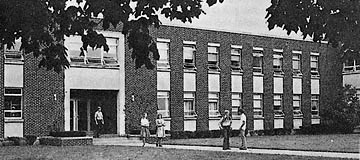
The fine arts building was dedicated.
On Sept. 2 with the strong endorsement of Johnson, R.D. Gunsalus was hired as director of development and assistant to the president. He found two buildings already under construction, proposed an immediate development campaign of $1,750,000 in order to put $500,000 into endowment and to build a new cafeteria.
In the fall U.S. troops were used to enforce court-ordered segregation of the University of Mississippi in Oxford.
In October the Executive Committee of the Board voted to recommend to the full Board that Asbury adopt complete racial integration. The restrictions in the 1960 compromise policy would be dropped, and the “entrance requirements for Asbury College hereafter will apply to any student who meets the basic qualifications for admission.” These were listed, as approved by the Board. There were four: good physical and mental health, good character, adequate scholastic records and “average ability as indicated by college entrance tests.”
The Education Department completed a ten-year self-evaluation for NCATE accreditation.
1963
In January the Board agreed to raise enrollment to 1200. The administrators told them that sufficient classroom and dining hall facilities existed or were in the planning stage, but that there was not enough residence hall capacity for increased enrollment. The board authorized additional construction of residence halls. The board, acting on the fall recommendation of the executive committee, approved complete racial integration.
During Feb. 4-6 a visiting team came from NCATE. As a result of their review, the College was approved for continued membership. However there were several areas in which improvement was needed “as soon as feasible.” A supplementary mid-term report was called for when these improvement were completed.
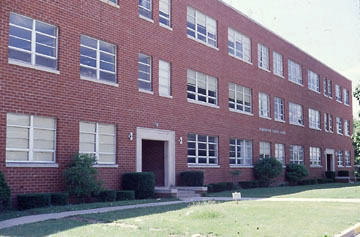
A new science building was completed. The old science building, originally constructed as a gym, was refitted as the Education-Psychology Building.
The budget for fiscal year 1963-1964 was $1,047,500—the first to exceed one million dollars.
Martin Luther King, Jr., led a massive march on Washington in August, to demand national desegregation. On Augs 28 he delivered the famous “I Have a Dream” speech.
On Nov. 22 President John F. Kennedy was assassinated. He was succeeded by Vice President Lyndon B. Johnson.
Also in this year, ZIP (Zone Improvement Plan) codes were introduced by the U.S. Mail.
1964
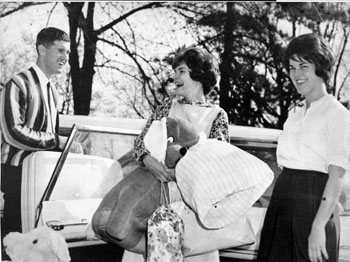
In January the board approved Johnson’s proposal that a committee be established to plan a special celebration of the College’s 75 anniversary in 1965. Unusually, the committee, which was chaired by the board chairman, contained an equal number of Board members, faculty and student leaders. The board also returned to the “chancellor” plan for Johnson while launching a national search for a new president for the College. The target date for both was June 1, 1965.
On Aug. 2 naval forces of North Vietnam attacked two U.S. destroyers in the Gulf of Tonkin. The U.S. Senate responded with a Resolution authorizing President Lyndon Johnson to use military force to defend U.S. personnel from direct attack.
The “Free Speech Movement” began in the fall at the University of California, Berkeley. Unrest spread to other campuses. The great issues of the decade seemed to have passed by Asbury, which the majority of administrators and faculty regarded as a blessing that was not in disguise. In fact the students were not entirely inert.
The “Singing Ambassadors,” a mixed choral group of students that traveled and performed off campus was formed by Professor Jack Rains.
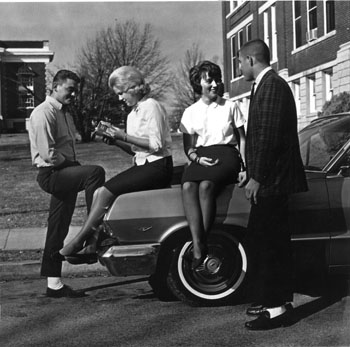
The Board endorsed a new retirement plan for faculty, who could choose between a College-sponsored program and the nationwide TIAA-CREF program.
Construction began on yet another new men’s residence hall, Trustees Hall East Wing.
In November Lyndon B. Johnson, Democrat, was elected President.
At Thanksgiving the new Z. T. and Sarah Johnson Cafeteria was opened. Johnson noted that it had been designed to look like a “B-57 bomber with a main section and two swept-back wings.”
1965
As a result of a Communist attack at Pleiku, the U.S. began a direct combat mission in Vietnam.
On April 21 the Board elected Dr. Karl Wilson to succeed Dr. Johnson as president when the latter retired in September 1966. Wilson was a graduate of Asbury College and Seminary, held a Ph.D. from Pittsburgh and had been a Methodist pastor for the past eleven years. At the same time the Board created three new administrative positions and filled them: vice president in charge of construction and maintenance (Z.T. Johnson, Jr.); vice president and dean (Custer B. Reynolds); vice president of development (R.D. Gunsalus).
The seventy-fifth anniversary edition of the Asburian was dedicated to Johnson, who had served as vice-president and president for thirty years. The “Asbury College March” retained its popularity and was quoted twice in the annual. The Vanguard class gift was “the Grill,” a student coffee shop opened in space on the second floor of the new cafeteria. It became popular with students at once.
In the fall, the College began its first formal self-study for renewal of formal accreditation by the Southern Association.
Trustees Hall, East Wing, was opened.
Faculty participation in TIAA-CREF retirement program became effective Dec. 1.
1966
In January Karl Wilson arrived on campus and by previous agreement with the Board became chair of the ongoing self study. He continued in this work until assuming the president’s office in September. The work did not go smoothly. There were complaints that Wilson attempted to guide the study committees toward certain conclusions.
When he became president on Sept. 1, Wilson halted all current planning projects, pending the outcome of the assessment of academic program needs that would result from the self-study. The new vice president for construction resigned and left at once. In addition, Wilson demoted Johnson’s son from vice-president status but left his job description as head of buildings and grounds the same.
Custer B. Reynolds became vice president and dean.
Wilson and the Dean tried to bring order out of the confusion of Johnson’s faculty rank and salary structure. Those who lost by this process quickly lost confidence in Wilson. Less necessarily, the new president tried to impose his own version of social control on both faculty and students. Discontent spread.
Also this year the Federal work-study program for student employment began on campus.
The Oriental Missionary Society (OMS) opened a Student Center in Wilmore.
The Student Handbook issued in the fall was the last to include the “Asbury College March.”
1967
New faculty contracts were issued on Feb. 23, 1967. Among the conditions of employment were adherence to “the moral and doctrinal position upheld by the College.” These included a rule against attending motion picture theaters and a commitment to the “creationist view of origins.”
Also in February the provisions of the Fair Labor Standards Act began to apply nationwide to the employees of colleges and universities. Among other provisions the law required the payment of minimum wage and overtime pay.
On March 28 Karl Wilson became the first president of the College to have a formal inauguration. Guests included Senator Mark Hatfield, W.R. Cannon of the Chandler School of Theology, Governor Ed. T. Breathitt and 196 delegates and representatives of other institutions.
In April a group of 30 faculty petitioned the board to call a special meeting to investigate the deteriorating conditions on campus. The board held several meetings to address these issues. These hearings were conducted fairly. On May 23 a member of the board, Ford Philpot, a Lexington evangelist, read a statement in chapel, saying that the board, sympathetic to the many complaints, had in fact disallowed the controversial faculty contracts and several of Wilson’s other recent decisions, but now asked for sympathy and patience. The campus community should concentrate on the College mission. Ford noted that no college in the U.S. had done more to supply Christians to change the world.
In May the College agreed to the City of Wilmore’s request to purchase the college-owned water system, pending agreement on terms.
Wilson’s presidency continued to falter. During the summer the executive committee and other concerned persons met to discuss this matter.
The first faculty retreat was held in the fall.
In the fall Asbury enrolled the first American black student. This was Edward E. Williams of Memphis, who had learned of the College from an Asbury student working in Operation Mobilization in a U.S. Air Force base in Turkey, where Williams was stationed. He took general education courses and remained only for one academic year. (He returned for summer school 1969.)
Also in the fall, a subcommittee of the Student Faculty Committee substantially revised the student body constitution.
The Education Department submitted a supplemental self-study review, as required by NCATE in 1963. An official of NCATE visited campus Dec. 4-5. In reporting to the board Custer B. Reynolds, declared that continued accreditation of the college education program was “exceedingly important.” Reciprocity of credential approval was critical to Asbury, which now had “graduates in teacher education teaching in every state in the Union.” He added that Asbury’s faculty showed “loyal and enthusiastic support” for the Education Department by joining both the Kentucky and National Education Associations. Asbury had the highest percentage of faculty membership of any college in Kentucky.
In December a group of trustees decided that action against Wilson could no longer be delayed. Each plan for board cooperation and support for him had failed to last. When the kindly chairman proved reluctant to take more drastic action, worried trustees went forward anyway. A clear quorum was present at the meeting held at the Springs Motel in Lexington on Dec. 28, at which the Board removed Wilson from office. He was replaced by Cornelius R. Hager, an experienced administrator at the University of Kentucky and a leading Methodist layman in the state, as interim president.
Edgar Pittenger became business manager. Gayle Horn, retired Superintendent of Jessamine County Schools, became director of development.
1968
Wilson did not accept these developments willingly. Beginning in January, various meetings of the Board were held to find a settlement. Hager was confirmed in office and took up his difficult duties.
In the winter quarter, the first election under the revised student body constitution was held. Changes included a new name for the organization, substituting the more dignified-sounding “council” for “committee.” Two new officers were created (treasurer and secretary). The duties of Spiritual Life Coordinator were expanded and residence hall councils were created.
Explaining to the board that “more wholesome recreational facilities” must be provided for students, President C.R. Hager had television sets placed in the lobbies in each residence hall.
In April the College, seminary and city each paid one-third of the cost of a new fire engine for the Volunteer Fire Department.
In the same month the board appointed a screening committee to search for a new president. In response to a request from senior faculty, the board created a Faculty Advisory Committee to assist with the search. When this committee polled the faculty, they were told that 34 out of the 39 faculty interviewed “strongly desired” C.R. Hager to remain as president. The board, however, had gone forward on the assumption that Hager had only a leave of absence from the University, and was under obligation to return to that institution.
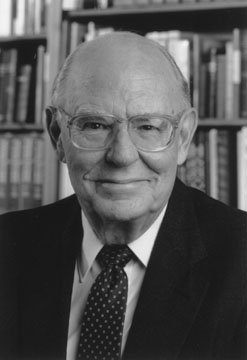
The Board selected Dennis Kinlaw as president in June. Kinlaw was a distinguished Old Testament scholar at Asbury Theological Seminary and a leading proponent of Wesleyan doctrine.
In the fall the new president created a more consultative administrative model. It centered on a new “Administrative Council” to be made up of the academic dean, dean of students, director of development and college business manager.
A rule was introduced that prohibited male students from wearing beards or long hair.
The World Gospel Mission (WGM) opened a student center under DeeVee and Marge Brown.
In November Richard M. Nixon, Republican, was elected President.
1969
Harold Spann became the first dean of student affairs. Andrew F. Gallman was appointed director of development and Leon Fisher became the first director of counseling.
In the fall the social work major was started. A few faculty expressed concern that the College was turning towards pre-professional training, which weakened its commitment to the liberal arts. On the contrary, the administration and a clear majority among the teaching staff believed that strong career training could be firmly based on a “core” of liberal arts courses that would still be required for all academic majors. In any case, pre-professional programs were nothing new at Asbury.
Also in the fall, some 200 students committed themselves to the “Asbury College Great Experiment,” which called upon each of them to pray a half-hour daily, read the Bible, witness and in general encourage and help other people. From this several smaller groups emerged who were committed to pray for a revival at Asbury.
The first Parents’ Weekend was held on Oct. 1. As part of the weekend, a committee chaired by Grayson Chandley created a new parents’ organization.
The Staley Lectureship series was established on campus.